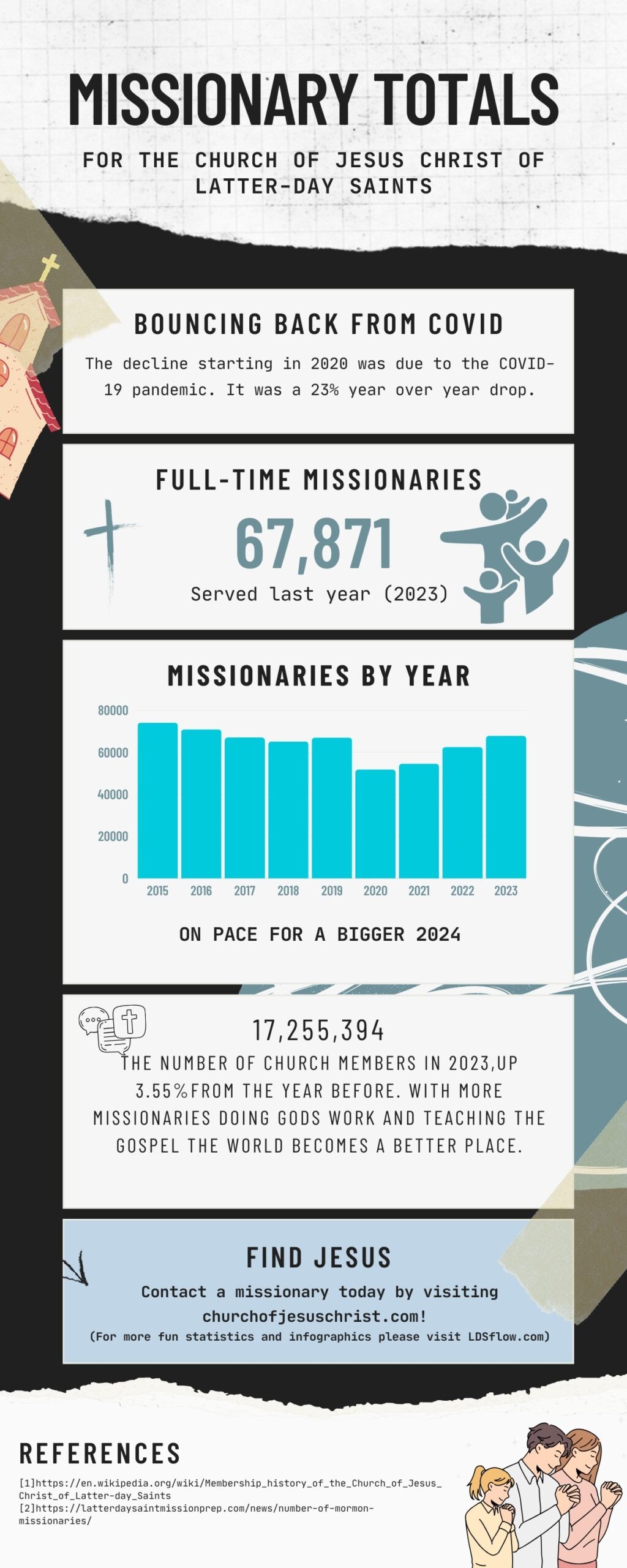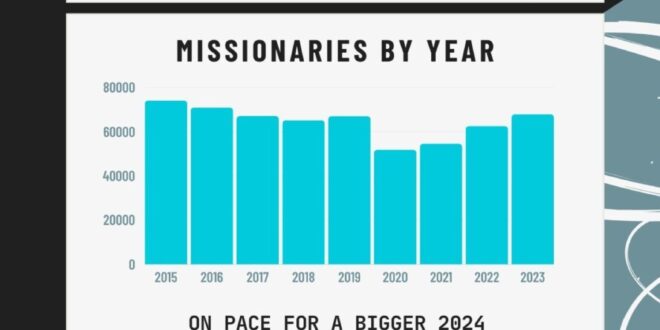The Church of Jesus Christ of Latter-day Saints has long emphasized the importance of missionary work, considering it a fundamental aspect of its global outreach and spiritual growth. As of December 31, 2023, the Church reported 67,871 full-time missionaries serving worldwide, marking a significant 9% increase from the previous year. This article delves into the historical trends, recent developments, and factors influencing missionary service within the Church.
Historical Trends in Missionary Numbers
Since 1977, the earliest year for which comprehensive data is available, the Church has meticulously tracked and reported the number of full-time missionaries serving annually. Over the decades, this number has generally shown an upward trajectory, reflecting the Church’s growing membership and emphasis on missionary work.

Key Milestones and Fluctuations
- Steady Growth (1977-2012): For most of this period, missionary numbers saw consistent growth, with occasional plateaus and minor fluctuations.
- The “Surge” (2012-2014): In October 2012, President Thomas S. Monson announced a landmark change in missionary age requirements. Young men could now serve at 18 (previously 19), and young women at 19 (previously 21). This led to a dramatic surge in missionary numbers, peaking at 85,147 in 2014.
- Post-Surge Adjustment (2015-2019): Following the initial surge, numbers stabilized at a new, higher baseline, reflecting a ‘new normal’ for missionary service.
- COVID-19 Impact (2020): The global pandemic caused an unprecedented disruption. Missionary numbers plummeted by 23% year-over-year, the largest single-year decline in recorded history. This drop was primarily due to the Church’s decision to bring all missionaries to their home countries and offer them the choice to continue or postpone their service. Approximately 80% chose to continue.
- Recovery and Growth (2021-2023): Post-pandemic years have shown a steady recovery, culminating in the 9% growth seen in 2023.
Factors Influencing Missionary Numbers
- Age Requirement Changes: The 2012 age change has had a lasting impact, allowing more young adults to serve missions earlier in life.
- Global Church Growth: As the Church expands globally, the pool of potential missionaries increases.
- Cultural and Societal Factors: Changing attitudes towards religious service and global experiences influence young adults’ decisions to serve.
- Economic Conditions: Global and local economic situations can affect families’ ability to support missionary service.
- Church Policies and Emphases: Various Church initiatives and policy changes can influence missionary numbers.
- Technological Advancements: The integration of technology in missionary work has potentially made service more appealing to tech-savvy youth.
The Impact of Missionary Service
Missionary service not only contributes to the Church’s growth but also significantly impacts the lives of the missionaries themselves. Many return with increased cultural awareness, language skills, and personal growth. This transformative experience fosters spiritual maturity, independence, and emotional intelligence. Missionaries often develop strong leadership skills, a robust work ethic, and improved public speaking abilities.
The cultural immersion inherent in missionary work broadens worldviews and enhances cross-cultural communication skills, which are invaluable in our increasingly globalized world. Additionally, the rigorous nature of the service instills valuable time management and adaptability traits. Social and interpersonal skills are honed through constant collaboration with companions and interactions with diverse individuals. These acquired skills and perspectives frequently influence future career choices, educational pursuits, and approaches to civic engagement and family life.
The Church has adapted its missionary program over the years to enhance these benefits while maintaining its core purpose of sharing the gospel. Recognizing the evolving needs of both missionaries and the communities they serve, the Church has implemented various changes. These include integrating technology for proselyting purposes, allowing limited use of smartphones and social media to reach broader audiences. There’s an increased emphasis on community service projects, fostering a sense of global citizenship among missionaries.
The Church has also enhanced mental health support, acknowledging the challenges inherent in missionary work. Other notable adaptations include more personalized mission calls, tailoring assignments to individual skills and circumstances, and improved pre-mission cultural and language training to better prepare missionaries for their assigned areas. Post-mission support programs have been developed to help returning missionaries transition back to regular life and apply their newly acquired skills. These changes reflect the Church’s commitment to not only spreading its message but also to developing well-rounded, globally aware individuals who can contribute positively to society long after their missionary service has concluded.
Future Outlook
As the Church continues to grow and adapt to global changes, the nature and scope of missionary work are likely to evolve. The Church leadership regularly assesses and adjusts missionary policies to meet current needs and opportunities. Factors such as global health situations, geopolitical changes, and technological advancements will undoubtedly play a role in shaping the future of missionary service.
The number of full-time missionaries serving in The Church of Jesus Christ of Latter-day Saints has shown remarkable resilience and growth over the years. From the steady increases of the late 20th century to the dramatic surge in 2012-2014, through the challenges of the COVID-19 pandemic, and into the current period of recovery and growth, missionary service remains a cornerstone of the Church’s global outreach. As the Church moves forward, the dedication of these young men and women continues to play a crucial role in its mission to share its message worldwide.




